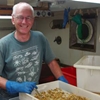General Description
Rostrum a little longer than broad at base, separated from orbital hoods by broad grooves; orbital hoods with broad teeth, one-third as long as rostrum; rostrum-hood margins continuous. Large claw (chela) laterally compressed; lower margin barely concave; upper margin almost straight; with strong acute lateral and mesial teeth near dactylar articulation; sixth segment (propodus) with weak longitudinal ridges, lateral one terminating at tooth; with only scattered setae. Small chela not of balaeniceps form. Bold bright red longitudinal stripes. Rare in Victorian waters. Up to 4.5 cm long.
Biology
Snapping shrimps or pistol shrimps are immediately distinguished by having one claw much larger than the other, the larger claw cylindrical and with a parrot-beak-like finger. The Narrow Snapping shrimp is so named because the large claw is laterally compressed. The shrimp usually lives in pairs, often in the burrow made by the file shell, Limatula strangei, a bivalve said to be distasteful to fish.
Habitat
Subtidal in reef, to depths of 5 m.
Reefs
Distribution guide
Southern temperate oceans, including southern Australia.
Species Group
Prawns, shrimps, lobsters › Shrimps
Depth
Water Column
Max Size
4.5 cm
Diet
Organic matter
Commercial Species
No
Global Dispersal
Recorded in Australia
Conservation Status
- DSE Advisory List : Not listed
- EPBC Act 1999 : Not listed
- IUCN Red List : Not listed









